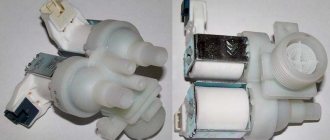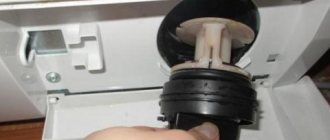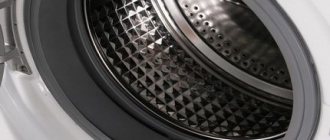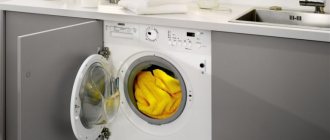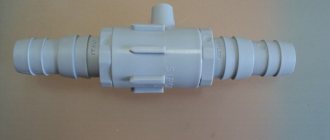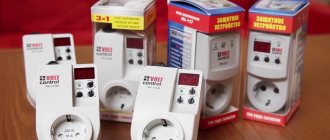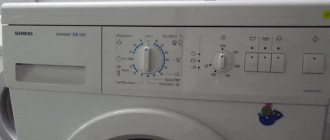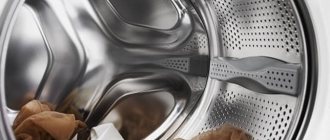Currently, a washing machine is an integral attribute in every apartment. Any housewife is interested in keeping her linens crystal clean. The quality of washing depends not only on the characteristics of the machine and powder, but also on the correct connection. The washing machine must not only pump clean water, but also ensure that waste water is discharged into the sewer system. As a rule, there are no problems with water injection. And illiterate organization of drainage can lead to a number of problems. Dirty water from sewer pipes can flow back into your car. To block the reverse flow of water, it is necessary to install a check valve on the drain hose of the washing machine, which is also called an anti-siphon.
Why do you need an antisiphon?
High-quality washing is impossible without an anti-siphon. Its main function is to pass dirty water into the sewer and prevent it from entering back. An anti-siphon is a small pipeline element with a tip for connecting to a hose and a built-in check valve. The diameters of the inlet and outlet pipes are different. Most often, this device is sold complete with a washing machine.
Anti-siphon valve
Without it, high-quality washing is only possible if certain operating conditions are met. The main condition is that the drain hose must be higher than the sewer pipes. Many people organize a drain right next to the floor in order to preserve the interior. This erroneous decision leads to an increase in the siphon effect. But even with a properly connected machine, problems can arise. If the sewer pipes have not been changed for a long time, a “siphon effect” also occurs when draining.
This is quite easy to determine. The operating time increases significantly, the quality of washing decreases, and energy costs increase. These are manifestations of the “siphon effect”. It appears if the drainage is not organized correctly. The diameter of the machine drain hose is much smaller than the diameter of the sewer pipe. Draining leads to a release of pressure, water is pumped out of the drum. The machine is forced to draw water from the water pipe and heat it. As a result, the operating time of the unit increases and water consumption increases. These problems can be avoided by installing a siphon with a check valve.
What are the advantages?
If it has already been discovered that the washing machine is connected to the sewer incorrectly, then there are no questions here. A solution to the problem is needed, sometimes very urgently.
But there are other situations when the recommended methods of connecting the drain hose to the sewer are simply not feasible. But I don’t want to use an alternative method - securing the hose to the edge of the bathtub, sink or toilet using a holder. It is in this case that the use of a check valve becomes an ideal option.
Example: the design “drain hose + check valve + sewer pipe” can easily be placed around the bathroom. After this, all that remains is to install a special screen. This solution has one significant drawback. If you have to replace the check valve, access to it may be difficult. It is recommended to avoid this option.
Operating principle of a check valve
A siphon with a check valve is mounted on the drain pipeline in an arbitrary location. When the drain program is turned on, the pump starts to pump out water. The pressure in the hose increases and water flows freely through the valve. After the drain cycle completes, the water stops flowing and the pressure drops. In this case, the device closes, blocking the passage. A tight connection is formed. In this way, the passage for water to enter the drum from the pipe is blocked. Due to the height difference between the inlet and outlet pipes, the reaction time to pressure changes is minimal.
The most commonly used locking device is:
- polypropylene ball;
- spring.
How the anti-siphon works
The locking mechanism is a small ball of air. When direct fluid pressure is removed, the ball rests against the sealing membrane. When back pressure occurs, the force of pressing the ball against the membrane only increases. Reverse penetration of liquid is not possible.
No ball cleaning required. Special ribs in the valve body serve for self-cleaning of the ball. A siphon with a spring valve uses a spring as the closing mechanism.
The design of the mechanism makes it possible to install it on any section of the pipeline. The installation location does not affect the quality of work.
All valve modifications are made of high-quality durable plastic. Therefore, the devices have a long service life. The service life can only be affected by water quality. Too hard water in the water supply system destroys the elements of the device.
Connection to sewerage
When transferring the drain from the machine to the drainage system, it is necessary to take into account all the factors that play an important role in the efficiency and quality of operation of the equipment and the drainage system.
Depending on the practicality of the location of the equipment and the sewage system, the outlet of dirty water from the “washing machine” can be formed in various ways: directly into the bathtub (this is not the most aesthetic way), by attaching a coil of hose to a special outlet in the siphon under the sink and combining it with sewer pipes.
The most practical and common is draining directly into the sewer system or with a permanent connection. This connection is the most acceptable in any bathroom. In this case, it is necessary to take into account some important conditions, the main one of which is the height of the connection of the drain hose to the sewer pipe.
If it is not possible to meet the requirements, installing a check valve for draining water from the washing machine remains a fairly easy and reliable type of connection. The introduction of a drain system using an “anti-siphon” is an excellent alternative to solve the problem.
Types of check valves
There are several types of antisiphons for washing machines:
- collapsible (segmental);
- non-separable;
- wall;
- mortise;
- washing
Types of antisiphons
Double check valve
Wall-mounted check valve
Demountable devices are best chosen for homes with hard water. If it gets dirty, it can be dismantled and disassembled. Without cleaning, the device can quickly fail. In addition, only such valves are suitable for certain brands of washing machines (for example, from the manufacturer LG). This is usually stated in the instructions for the washing machine. If the water is of good quality, a non-separable option is quite suitable. It is much cheaper than segment ones.
Non-separable valves are subject to forced replacement. Devices need to be checked and replaced more often with hard water.
Mortise devices are convenient to use when connecting a direct drain into a sewer pipe. To install the valve, a special mortise hole is prepared in the pipe. This connection option is somewhat more complicated.
Wall-mounted ones have the most aesthetic appearance. But they are significantly more expensive than others. It is mounted between the washing machine and the wall. This is the most compact device.
Wall check valve
The washer is not suitable for washing machines. Their purpose is a sink siphon. There are also many models with decorative inserts. Inserts are usually made of high quality stainless steel. But such models are several times more expensive. But it should be remembered that appearance does not affect quality.
There are no special rules when choosing an antisiphon. The main thing is that the device fits the washing machine and the drainage structure. Therefore, first of all, you need to carefully study the machine’s instructions and the design features of the sewer pipes.
Features of use
The choice of device directly depends on the condition of the tap water. With good quality water, it is advisable to change the valve once every couple of years. The segment element is used to work with low-quality water; it is necessary to periodically disassemble it and clean it of debris and scale.
Not all household appliance companies provide a check valve in the basic kit. For example, they come included with Miele washing machines, but it is better to check this with a consultant when purchasing, because Models may vary. If the valve is not included in the kit, it can be immediately purchased separately from a specialized store.
Connecting a drain using a valve makes it possible not to follow the recommendations for the height of the drain hose. It is important during use to ensure free access to the valve in case of cleaning or repair.
Under the influence of hard tap water, the valve quickly fails, which is the reason for frequent (every few years) purchase of a new one. Therefore, it is worth paying attention to the price - low cost does not guarantee good quality of the product.
DIY installation
Installing the device is not particularly difficult. The installation principle for all varieties is approximately the same:
- connect the siphon to the valve tube (for mortise ones - install it in a pre-prepared cutout in the pipe);
- connect the second output to the drain hose of the washing machine;
- seal all joints with sealant.
Antisiphon tubes have different diameters. Therefore, incorrect connection is completely excluded. The most important thing is to ensure the tightness of all connections.
It must be remembered that in drain mode there is strong vibration of the hose. High-quality connections will help avoid leaks. Before starting, it is necessary to check the operation of the sewer system. If water flow is poor, the pipes need to be cleaned.
Self-installation
Draining a washing machine through a non-return valve is not a difficult task for a home craftsman. You will need very little experience working with pipes and plumbing. Plus a standard set of tools (determined by the material of the check valve and pipes), as well as sealant. Since there are quite a few models of check valves and washing machines, the best option is to follow the instructions.
The most important moment of installation is testing the entire system. It must be carried out in a mode with a low level of responsibility. You can do a short wash or rinse cycle. During the process of draining water, it is important to carefully monitor the condition of all connections. Leaks and even simple wetting of joints indicate insufficient quality of work . It is necessary to eliminate shortcomings and retest.
What should you do if the installation seems to have been successful, but the washed items in the machine still become dirty, and the odors have not gone away? The most likely reason for this situation is a defective check valve, failure after long intensive use, or clogging with water suspensions. Using a collapsible model allows you to protect yourself a little from such cases.
Is it possible to do without a check valve?
Yes, but only if there is a guarantee that the washing machine will be absolutely correctly connected to the sewer. Another option is when a blocking device is provided by the design of the washing machine. If this is not the case, and it is also impossible to raise the drain hose to the recommended height of half a meter, then in principle you cannot do without a check valve. There are no analogues to such a device yet, and it is impossible to put up with a constant siphon effect.
If you choose the right check valve, install and connect the washing machine, then the entire system will work properly and simply work perfectly without any difficulties.
Which manufacturers are better
Check valves for washing machines can be purchased at any hardware store. The variety of manufacturers and price range is quite wide. To ensure that the device works for a long time, when purchasing, it is better to give preference to trusted suppliers. The table shows the most common devices from well-known brands.
| Manufacturer | Type | Characteristics |
| Alcaplast, Czech Republic | APS2 | Plastic, ? 32 mm, for any hoses, one-piece |
| Siroflex, Italy | 012677 | Mortise, spring. |
| Merloni, Italy | 95101800 | Mortise, plastic |
| McALPINE, Scotland | WMV-32WH | Plastic, ? 19-25×32, one-piece |
| ANI Plast | P-12/M500/APS2 | Minisiphon (wall-mounted) |
Whether or not to install a siphon with a check valve is up to everyone to decide for themselves. But you should remember that without it it is impossible to organize a drain. The quality of washing decreases, washing time, water and electricity consumption increases. An inexpensive device that is easy to install even without the involvement of specialists will help avoid these problems.
Tips for selection and installation
Experts advise when choosing a drain valve to get advice from a service center, or from a technician who has good experience in installing washing machines.
The technical rules for installation must be carefully studied. An error in connection may result in malfunctions of the machine and serious damage, which will result in refusal of repairs under warranty. In case of malfunctions during installation or use of the washing machine, you must obtain qualified advice from a service center.
The check valve is easy to use, has a reasonable price, and eliminates a lot of hassle during the washing process. With the use of a check valve, you can be sure of high quality washing and lower costs of water and electricity.
Kinds
There are several types of check valves on the modern plumbing equipment market. They differ in design features, type of installation and scope of application.
Main types of antisiphons:
- collapsible - a metal device consisting of several parts; this type is convenient because, if necessary, it can be disassembled and cleaned;
- non-removable - monolithic structure made of plastic; considered the most budget option;
- mortise - a valve that is installed directly into the pipe, in place of a piece cut out of it;
- washing – check valve intended for use in drain siphons of sinks and washbasins;
- wall-mounted – a beautiful structure made of chromed metal that is mounted on the wall; the most expensive option of all of the above.
